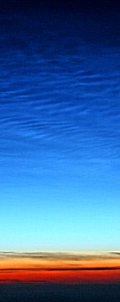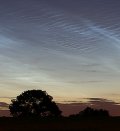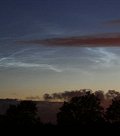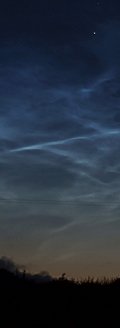| |
Observing
tips: Look
west 30 to 60 minutes after sunset when
the Sun has dipped 6o to 16o below the horizon.
If you see luminous blue-white tendrils spreading across the sky,
you've probably spotted a noctilucent
cloud. Although
noctilucent clouds appear most often at arctic latitudes, they have
been sighted in recent years
as far south as Colorado, Utah and Virginia. NLCs are seasonal,
appearing most often in late spring and summer. In the northern
hemisphere, the best time to look would be between mid-May and the
end of August. See also 2003,
2004, 2005,
2006 and 2007. |
 |
| |
| |
Photographer,
Location |
Images |
Comments |
|

|
Brian Whittaker,
flying 35,000 feet over the very remote northern end of Quebec,
Canada.
Jun. 11, 2008 |
#1,
more |
I was excited
to see my first Noctilucent Clouds of the season on June
11th! This picture shows the view looking north toward Baffin
Island into the midnight twilight. It was a bright display
that impressed me and all who saw it. |
|


|
Daniel Robinson,
Wrightington, W Lancashire, England
Jun. 13, 2008 |
#1,
#2,
#3,
#4,
more |
Observed and
captured my first NLC display of the season on Thursday
night (June 12/13). First spotted at 2.15BST and lasted
until dawn. Brightest and most extensive display I've seen
so early in the season.
Photo
details: Canon
EOS 400D |
|

|
John
C McConnell,
Maghaberry, Northern Ireland.
Jun. 13, 2008 |
#1,
#2,
#3,
#4 |
This
was my first really spectacular display of the season. Every
form was visible including some which I've never seen before.
At one stage the display reached well above the altitude
of Capella.
Photo
details: Canon
400D, ISO800, 6-8 seconds with an 18-55mm lens mostly
working at f4.5. |
|

|
Martin
Mc Kenna,
Maghera, Co. Derry, Northern Ireland
Jun. 13, 2008 |
#1,
#2,
#3,
#4,
more |
Tonight the
clouds broke and I was amazed to see a spectacular NLC display
stretching from the NW to NE and reaching higher than golden
Capella. I didn't want my street lights to spoil my images
so I jogged out to the countryside and set my camera up
in a nice field. I was so excited that I only just noticed
that I was wearing a t-shirt. The NLC display was breathtaking!,
consisting of glowing blue and white structures which were
beyond description. They not only looked beautiful but moved
rapidly even with the naked eye!. I managed to get these
images before the clouds arrived. Fujifilm S6500 6.3MP at
ISO100 6-8 sec exp. |
|

|
Peter
Paul Hattinga Verschure,
Deventer, the Netherlands
Jun. 13, 2008 |
#1,
more |
A
beautiful display of noctilucent clouds above dark Stratocumulus
patches, from 00.55 UTC until disappearing in twilight at
02.20 UTC. |
|
|
|







